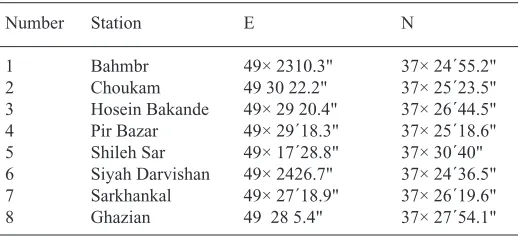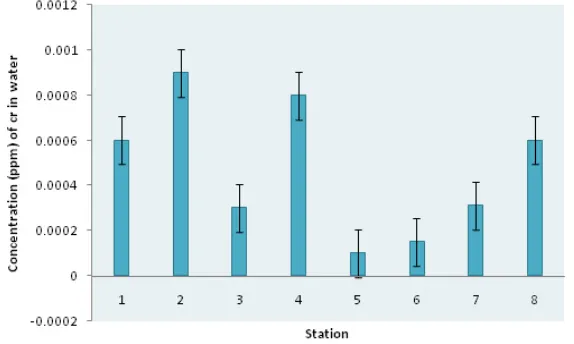* To whom all correspondence should be addressed.
Evaluation of Cd and Cr in Surface Sediments and Plants
of
Phragmites
australis
Anzali Wetland, Iran
Seyedeh Leila Hosseini1, Keivan Saeb and Sam Haieri Pur
Department of the Environment, Tonekabon Branch, Islamic Azad University, Tonekabon, Iran.
DOI: http://dx.doi.org/10.13005/bbra/1209
(Received: 25 October 2013; accepted: 14 December 2013)
A high rate of population growth, development of different industrial sectors, and expansion of agricultural lands together is generating a large volume of different pollutants that discharged into aquatic ecosystems. Environmental pollution by different contaminants in aquatic ecosystems can be monitored through water, sediments, and aquatic life. In this study, total concentration of heavy metals (Cadmium and Chromium) in water, sediments and reed (Phragmites australis; dominant aquatic plant of Anzali Lagoon) were measured. Anzali Lagoon located in Iranian province of Gilan and the southwest of Caspian Sea. Also, the lagoon has been registered as an international wetland in the 1971 Ramsar Convention. The total area is less than 200 Km2 (193Km2) and located between N 37° 24' and E 49° 35'. In order to evaluate, range of heavy metals (Cd, Cr), 8 stations sampling were selected and at each station, 3 samples (Water, sediment, and plant) were collected. All of samples, after preparation were analyzed with ICP-OES. The metal concentrations for Cd and Cr found in sediments were higher than plants, whereas metal concentrations for all plant bodies were similar. However, considering quality guideline values by US and Canadian EPA, the level of metal concentrations in sediments and water samples were lower than threshold effects.
Key words: Wetland, Phragmites australis, Sediment, Cd, Cr.
Nowadays, water pollution has been receiving a lot of international attention. Generally, water pollution threatens both human and animal health, which consequently affects aquatic ecosystems. It is well documented that water pollution, in the near future is the major risk for aquatic ecosystems, which pose serious stresses on environment. The main risk of pollution derived by heavy metals and their toxic effects is because of that they are stable an in ecosystems10. Wetlands as aquatic ecosystems have economic, social, educational, recreational values. Also, they improve the environmental quality for aquatic plants and animals, placing a third of
plants on nutrition of a large group of aquatic animlas, protection for nesting and spawning, biological activities of animals, filtration of aquatic ecosystems, minimizing re-suspension of sediment particles and reducing water velocity indicating how significantly aquatic plants, in particular macrophytes, maintaining resilience of an ecosystem9.Heavy metals are unwanted pollutants in natural environments that have serious risk of toxicity in contaminated environments, which their stability and accumulation followed by series of hazards. Therefore, accumulation of heavy metals in the environment has many risks for human and animals health2. Aquatic ecosystems, ground waters, soil and air, continuously are influencing by different forms of heavy metals, which released to environment by industrial plants. These contaminants, from the beginning of their impacts within ecosystems reduce biological activities and possibly may cause a big loss of biomass3. Among contaminants, which enter into the aquatic environment, heavy metals have been highlighted specifically due to their toxic effects and potential bioaccumulation in many aquatic species8.
Aims
1. Measurements of total concentration of cadmium and chromium in tissues of reed (Phragmites australis)
2. Measurements of total concentration of cadmium and chromium in water and sediment
MAteriAls And Methods
In Anzali Lagoon, the collection of samples was carried out in August 2012. Thereafter, chemical analyses of heavy metals in 8 stations
were completed.
reasons for selection of stations
1. Availability of studied plant in selected stations
2. Confluence of rivers
3. Easy access and transportation to each station
4. Availability of enough water in selected stations
In order to achieve goals of the study it is required that concentration of metals in water, soil, sediment, and vegetation examined.
number of samples and reasons
At each station, totally 9 samples (3 water samples, 3 sediment samples, and 3 plant samples) were collected. To have an average of metal concentration in studied environment, 3 samples from each media (water, sediment, and plant) was planned.
sampling method
After a preliminary survey and field study of the site in 8 stations (Figure 1), based on vegetation density and entering rivers to the studied site, in three replicates performed. Plant samples at each station in three replicates was collected, followed by washing with wetland’s water4 and stored in plastic bags5. Also, at each station sediments samples in three replicate13 were taken by a grabber and stored in plastic bags. Water samples in three replicates were filled in glasses and with acid nitric 65% pH adjusted to less than 2 for preservation of samples for further metal analysis11. After sampling, all samples for preparation, digestion and determination of heavy metals were sent to the laboratory, where after acid digestion of the samples, each sample were analyzed by ICP-OES for levels of Cd and Cr.
table 1 . Geographical location of sampling stations
Number Station E N
Fig. 1. Entering Rivers to wetland and location of stations
Fig. 2. Chromium concentration (ppm) of plant samples in different stations of Anzali Lagoon
Fig. 4. Chromium concentration (ppm) of sediment samples in different stations of Anzali Lagoon
Fig. 5. Cadmium concentration (ppm) of sediment samples in different stations of Anzali Lagoon
conclusion
The station of Hosein Bakande has the highest concentration of chromium, which decreasing from east to west of the lagoon as in station of Shileh Sar the lowest concentration was observed.The result of this study indicated that heavy metal concentrations in all stations are lower than standard values recommended by Canadian and US EPA.
suggestion
1. Monitoring and controlling all industrial activities within wetland
2. Studying accumulating rate of other plant species for heavy metals
3. Regular assessment and quality of water, sediments, and animals of wetland
4. Development of treatment systems for urban and industrial wastewater
reFerences
1. Ayati, B,”Investingation of sanitary and industrial wastwwater effects on the Anzali reserved wetland” 2003.
2. AL-Yemni,M., Sher, H., El-sheikh, M. and M. Eid, E “bioaccumulation of nutrient and heavy metals by calotropis procera and citrullus colocynthis and their potential use as contamination indicators”. scientific Research and Essays 2011; 6(4): 966-976
3. Babaee, H., Khodaparast, H., Abedini, A., “Evaluation elements(cd,cu,fe,pb) surface sediments in the anzali wetland”.The 3 conference on Engineering Geology environmental in iran, 1383; 946-954.
4. Baldantoni, D., A., Alfani, P.D., Tommasi, G., Bartoli and santo,A.V.D.," Assessment macro
and microelement accumulation capability of two aquatic plants”.Environmental pollution 2004;
130: 149-156.
5. Cardwell, A.J., Hawker, D.W., and Greenway, M., "Metal accumulation in aquatic macrophytes from southeast Queensland, Australia". Chemosphere
2002; 48: 653-663.
6. Davis,j.,Klarich,G., Benifits of wetlands. 1379; 81.
7. Institute for sustanibale development environment(CENESTA), Economic analysis project final report social lagoon vol .2.in the anzali wetland ecological management plan. 1390; 24.
8. Khosravi, M., Bahramifar, M., Ghasempur, M., “Evaluation heavy metals(cd,pb,Hg,zn,cu) in surface part anzali wetland”.Jornal of environmental Heaith,1390; 4(2): 223-232. 9. pirasteh,M.,Sabetraftar,K., Anzali wetland
conservation plan and reconstruction.1374; 2. 10. Rahim, M. “Evaluation of metal pb and its
effect on liver tissue of fish(cyprinus carpio) in the river sefidrud and anzali wetland”.marin biology masters thesis Islamic anzali university, Tehran science & research. 1387; 2.
11. Ramalhosa,E.,Segade,S.R.,Pereira,E.,Vale,c.and Duarte,A.”Mercury cycling between the water column and surface sedimenta in a contaminated area”.water Research 2006; 40:2893-2900. 12. Shahsavaripur,N.,Esmaeli sari,A.,Vahabzade
rudsari,H., “Biomonitoring and evaluation of mercury contamination in the international Anzali wetland using aquatic plants”.jornal of environmental science and technology, 1386;
11(3): 270-280.


